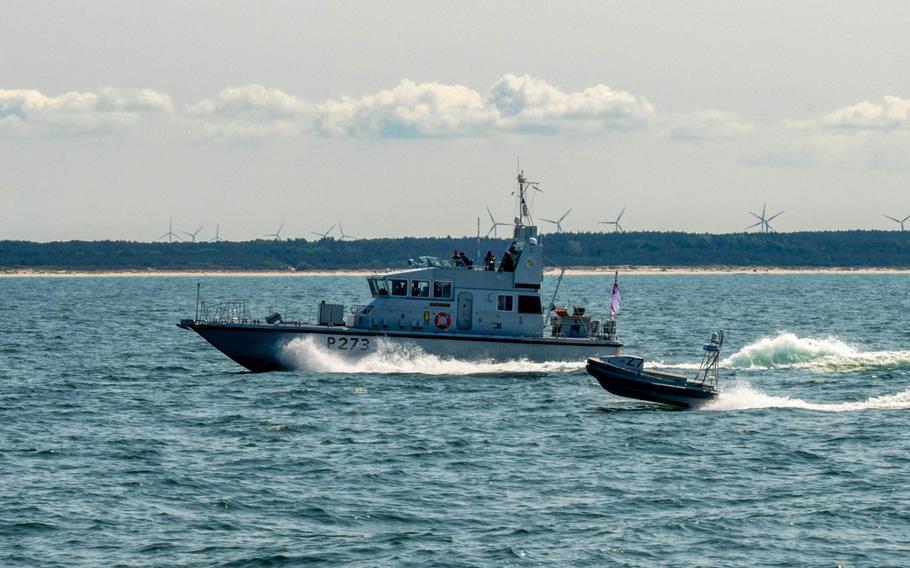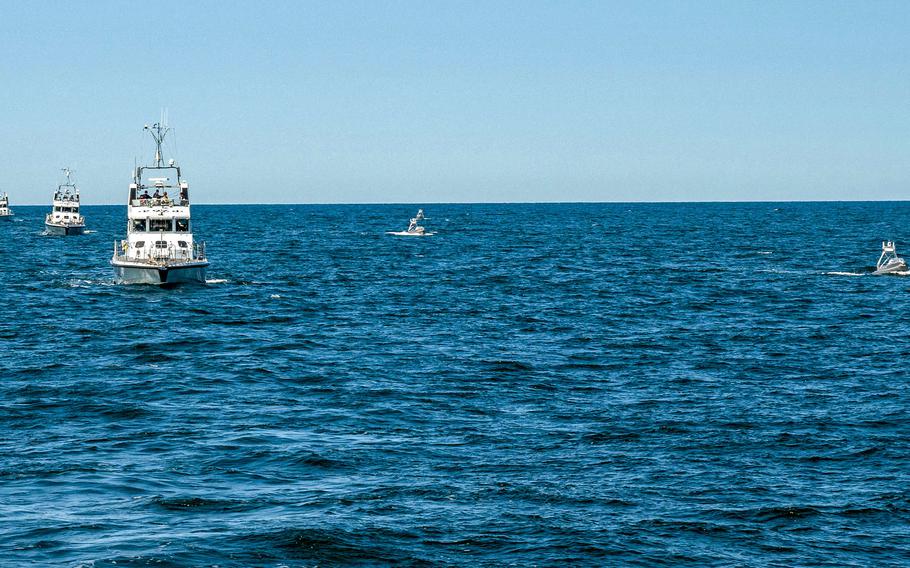
The British navy patrol vessel HMS Pursuer conducts operations in the Baltic Sea with an autonomous reconnaissance craft from Task Force 66 during the BALTOPS exercise June 12, 2025. ( Christine Montgomery/U.S. Navy)
NAPLES, Italy — Ukraine’s Black Sea operations against Russia are shaping U.S. Navy and NATO thinking on the future of drones, mines and missile tactics in global maritime warfare, one of the service’s top leaders in Europe and Africa said.
The Navy is focusing on tools to deny opponents the ability to go on offense, Rear Adm. Michael Mattis, the commander of Task Force 66 and director of strategic effects for U.S. Naval Forces Europe-Africa, said in a recent interview.
Mattis said insights from the service’s Black Sea Battle Lab apply to the Baltic and eastern Mediterranean seas. But they could just as easily relate to the Indo-Pacific, including the archipelago waterways near Japan, Taiwan and the northern Philippines — areas where China contests territory held by American partners and allies.
The Navy applied some of those lessons this month during the multinational U.S. 6th Fleet-led BALTOPS exercise, when it used surface drones to simulate attacks on 6th Fleet flagship USS Mount Whitney and the destroyer USS Paul Ignatius.
Service members also used underwater drones to identify sea mines, a concern in the Baltic due to potentially tens of thousands of underwater explosives left behind after two world wars.
The diving drones also would be useful in tracking and addressing suspected Russian activities, such as anchor dragging incidents that have targeted communication cables and other undersea infrastructure, Mattis said.
It “should have a very good deterrent effect and ensure that Russia understands that NATO is preparing and prepared to defend and deter here in the Baltic,” he said.
The Black Sea combat also is teaching the Navy about how an adversary like Ukraine, which had few ships and no blue-water presence, could devastate a technologically superior foe — and how to counter such attacks.
Early on, Ukraine targeted Russian ports and moved on to attacking ships in the Black Sea, without much success in sinking them. They didn’t have enough drones and lacked air, cyber and space support.

British navy patrol vessels HMS Pursuer, HMS Biter and HMS Archer take part in operations to counter unmanned surface vessels alongside autonomous reconnaissance craft from Task Force 66 during the BALTOPS exercise June 12, 2025. (Christine Montgomery/U.S. Navy)
In early 2024, Ukraine had the drones and other needed capabilities, ultimately sinking three Russian ships from January to March of that year, according to the Navy.
Overall, Ukraine has disabled about 40% of the Russian Black Sea Fleet and denied its ships access to a sizable portion of the sea, Mattis said.
Russia responded to Ukrainian attacks with fighter jets, surveillance planes, aerial drones and other aircraft. That response was answered by Ukrainian air-to-air missiles launched from surface drones that took down a Russian helicopter in December and a fighter jet early in May.
The Black Sea battle demonstrates that there is no perfect technology, capability, tactic or procedure in the future of warfare. Rather, it’s about innovating and training to stay ahead of the adversary and generate surprise, Mattis said.
The aim is to integrate cruise missiles, surface and aerial drones, deception mechanisms and other tools to create “dilemmas where the adversary is only going to have so much defensive capability and something will get through to generate the effect,” he said.
That won’t work in places such as the Atlantic and Pacific oceans, however, because the large number of drones needed in such vast expanses wouldn’t be efficient or cost-effective, Mattis cautioned.
Lessons gleaned “are not perfect translations of what we’re going to need to use in the Pacific, but there’s certainly insights of what the future fight with unmanned and robotic and autonomous systems might look like,” Mattis said.
Also, the type of asymmetry created by Ukraine challenged the Navy’s conventional capabilities in the recent battles with Iran-backed Houthi militants in the Red Sea, Mattis said.
The group began attacking commercial and military ships with drones and missiles in November 2023. In response, the U.S. formed Operation Prosperity Guardian in December 2023 to protect vessels in the Red Sea, ultimately launching an aggressive airstrike campaign in March aimed at stopping Houthi attacks.
In declaring a ceasefire on May 6, President Donald Trump said the Houthis didn’t want to fight anymore and had agreed to stop attacking ships in the vital waterway.
As of January, U.S. forces had fired more than 200 missiles costing millions of dollars each to defend against the militants’ drone and missile attacks, Vice Adm. Brendan McLane, commander of Naval Surface Forces, said the same month.
But U.S. forces adapted and were able to detect Houthi assaults more quickly.
That allowed 5-inch guns and air defenses from U.S. aircraft carriers to address threats more efficiently and cost-effectively, Mattis said.
Further innovation could see cheaper Hellfire or VAMPIRE missiles used in defending against Houthi attacks. The U.S. has supported Ukraine with those counter-air capabilities against Russia, he added.
“We have a much more effective understanding of the environment because we’ve tuned our radars with software and because we’ve been able to build standoff from that,” Mattis said. “That asymmetry is coming in line.”